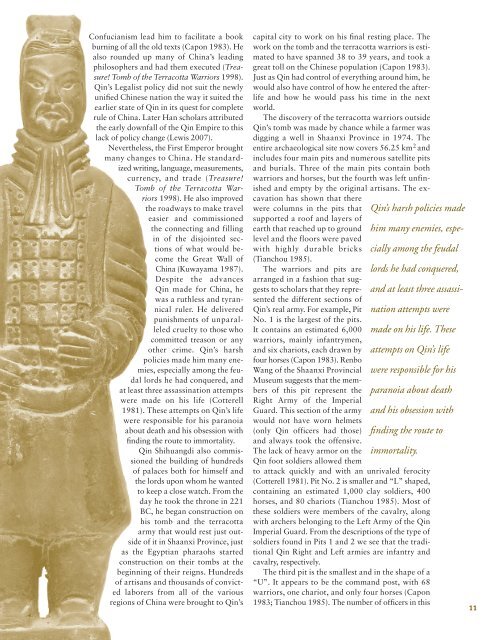Emperor Qin in the Afterlife
Create successful ePaper yourself
Turn your PDF publications into a flip-book with our unique Google optimized e-Paper software.
Confucianism lead him to facilitate a book<br />
burn<strong>in</strong>g of all <strong>the</strong> old texts (Capon 1983). He<br />
also rounded up many of Ch<strong>in</strong>a’s lead<strong>in</strong>g<br />
philosophers and had <strong>the</strong>m executed (Treasure!<br />
Tomb of <strong>the</strong> Terracotta Warriors 1998).<br />
<strong>Q<strong>in</strong></strong>’s Legalist policy did not suit <strong>the</strong> newly<br />
unified Ch<strong>in</strong>ese nation <strong>the</strong> way it suited <strong>the</strong><br />
earlier state of <strong>Q<strong>in</strong></strong> <strong>in</strong> its quest for complete<br />
rule of Ch<strong>in</strong>a. Later Han scholars attributed<br />
<strong>the</strong> early downfall of <strong>the</strong> <strong>Q<strong>in</strong></strong> Empire to this<br />
lack of policy change (Lewis 2007).<br />
Never<strong>the</strong>less, <strong>the</strong> First <strong>Emperor</strong> brought<br />
many changes to Ch<strong>in</strong>a. He standardized<br />
writ<strong>in</strong>g, language, measurements,<br />
currency, and trade (Treasure!<br />
Tomb of <strong>the</strong> Terracotta Warriors<br />
1998). He also improved<br />
<strong>the</strong> roadways to make travel<br />
easier and commissioned<br />
<strong>the</strong> connect<strong>in</strong>g and fill<strong>in</strong>g<br />
<strong>in</strong> of <strong>the</strong> disjo<strong>in</strong>ted sections<br />
of what would become<br />
<strong>the</strong> Great Wall of<br />
Ch<strong>in</strong>a (Kuwayama 1987).<br />
Despite <strong>the</strong> advances<br />
<strong>Q<strong>in</strong></strong> made for Ch<strong>in</strong>a, he<br />
was a ruthless and tyrannical<br />
ruler. He delivered<br />
punishments of unparalleled<br />
cruelty to those who<br />
committed treason or any<br />
o<strong>the</strong>r crime. <strong>Q<strong>in</strong></strong>’s harsh<br />
policies made him many enemies,<br />
especially among <strong>the</strong> feudal<br />
lords he had conquered, and<br />
at least three assass<strong>in</strong>ation attempts<br />
were made on his life (Cotterell<br />
1981). These attempts on <strong>Q<strong>in</strong></strong>’s life<br />
were responsible for his paranoia<br />
about death and his obsession with<br />
f<strong>in</strong>d<strong>in</strong>g <strong>the</strong> route to immortality.<br />
<strong>Q<strong>in</strong></strong> Shihuangdi also commissioned<br />
<strong>the</strong> build<strong>in</strong>g of hundreds<br />
of palaces both for himself and<br />
<strong>the</strong> lords upon whom he wanted<br />
to keep a close watch. From <strong>the</strong><br />
day he took <strong>the</strong> throne <strong>in</strong> 221<br />
BC, he began construction on<br />
his tomb and <strong>the</strong> terracotta<br />
army that would rest just outside<br />
of it <strong>in</strong> Shaanxi Prov<strong>in</strong>ce, just<br />
as <strong>the</strong> Egyptian pharaohs started<br />
construction on <strong>the</strong>ir tombs at <strong>the</strong><br />
beg<strong>in</strong>n<strong>in</strong>g of <strong>the</strong>ir reigns. Hundreds<br />
of artisans and thousands of convicted<br />
laborers from all of <strong>the</strong> various<br />
regions of Ch<strong>in</strong>a were brought to <strong>Q<strong>in</strong></strong>’s<br />
capital city to work on his f<strong>in</strong>al rest<strong>in</strong>g place. The<br />
work on <strong>the</strong> tomb and <strong>the</strong> terracotta warriors is estimated<br />
to have spanned 38 to 39 years, and took a<br />
great toll on <strong>the</strong> Ch<strong>in</strong>ese population (Capon 1983).<br />
Just as <strong>Q<strong>in</strong></strong> had control of everyth<strong>in</strong>g around him, he<br />
would also have control of how he entered <strong>the</strong> afterlife<br />
and how he would pass his time <strong>in</strong> <strong>the</strong> next<br />
world.<br />
The discovery of <strong>the</strong> terracotta warriors outside<br />
<strong>Q<strong>in</strong></strong>’s tomb was made by chance while a farmer was<br />
digg<strong>in</strong>g a well <strong>in</strong> Shaanxi Prov<strong>in</strong>ce <strong>in</strong> 1974. The<br />
entire archaeological site now covers 56.25 km 2 and<br />
<strong>in</strong>cludes four ma<strong>in</strong> pits and numerous satellite pits<br />
and burials. Three of <strong>the</strong> ma<strong>in</strong> pits conta<strong>in</strong> both<br />
warriors and horses, but <strong>the</strong> fourth was left unf<strong>in</strong>ished<br />
and empty by <strong>the</strong> orig<strong>in</strong>al artisans. The excavation<br />
has shown that <strong>the</strong>re<br />
were columns <strong>in</strong> <strong>the</strong> pits that<br />
supported a roof and layers of<br />
earth that reached up to ground<br />
level and <strong>the</strong> floors were paved<br />
with highly durable bricks<br />
(Tianchou 1985).<br />
The warriors and pits are<br />
arranged <strong>in</strong> a fashion that suggests<br />
to scholars that <strong>the</strong>y represented<br />
<strong>the</strong> different sections of<br />
<strong>Q<strong>in</strong></strong>’s real army. For example, Pit<br />
No. 1 is <strong>the</strong> largest of <strong>the</strong> pits.<br />
It conta<strong>in</strong>s an estimated 6,000<br />
warriors, ma<strong>in</strong>ly <strong>in</strong>fantrymen,<br />
and six chariots, each drawn by<br />
four horses (Capon 1983). Renbo<br />
Wang of <strong>the</strong> Shaanxi Prov<strong>in</strong>cial<br />
Museum suggests that <strong>the</strong> members<br />
of this pit represent <strong>the</strong><br />
Right Army of <strong>the</strong> Imperial<br />
Guard. This section of <strong>the</strong> army<br />
would not have worn helmets<br />
(only <strong>Q<strong>in</strong></strong> officers had those)<br />
and always took <strong>the</strong> offensive.<br />
The lack of heavy armor on <strong>the</strong> immortality.<br />
<strong>Q<strong>in</strong></strong> foot soldiers allowed <strong>the</strong>m<br />
to attack quickly and with an unrivaled ferocity<br />
(Cotterell 1981). Pit No. 2 is smaller and “L” shaped,<br />
conta<strong>in</strong><strong>in</strong>g an estimated 1,000 clay soldiers, 400<br />
horses, and 80 chariots (Tianchou 1985). Most of<br />
<strong>the</strong>se soldiers were members of <strong>the</strong> cavalry, along<br />
with archers belong<strong>in</strong>g to <strong>the</strong> Left Army of <strong>the</strong> <strong>Q<strong>in</strong></strong><br />
Imperial Guard. From <strong>the</strong> descriptions of <strong>the</strong> type of<br />
soldiers found <strong>in</strong> Pits 1 and 2 we see that <strong>the</strong> traditional<br />
<strong>Q<strong>in</strong></strong> Right and Left armies are <strong>in</strong>fantry and<br />
cavalry, respectively.<br />
The third pit is <strong>the</strong> smallest and <strong>in</strong> <strong>the</strong> shape of a<br />
“U”. It appears to be <strong>the</strong> command post, with 68<br />
warriors, one chariot, and only four horses (Capon<br />
1983; Tianchou 1985). The number of officers <strong>in</strong> this<br />
<strong>Q<strong>in</strong></strong>’s harsh policies made<br />
him many enemies, especially<br />
among <strong>the</strong> feudal<br />
lords he had conquered,<br />
and at least three assass<strong>in</strong>ation<br />
attempts were<br />
made on his life. These<br />
attempts on <strong>Q<strong>in</strong></strong>’s life<br />
were responsible for his<br />
paranoia about death<br />
and his obsession with<br />
f<strong>in</strong>d<strong>in</strong>g <strong>the</strong> route to<br />
11



